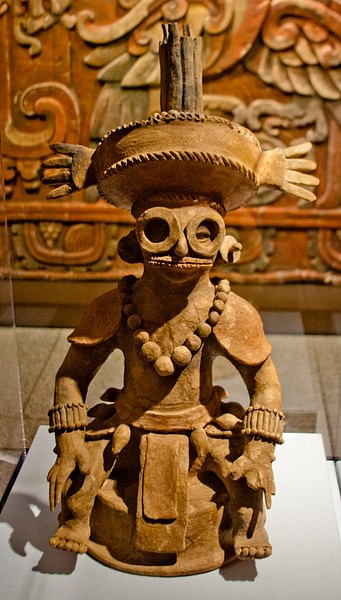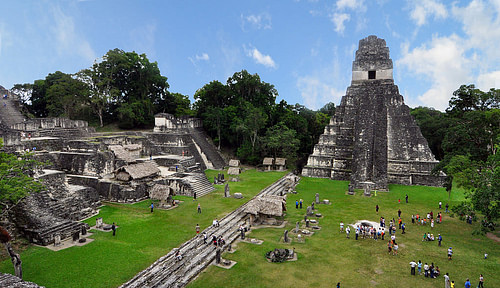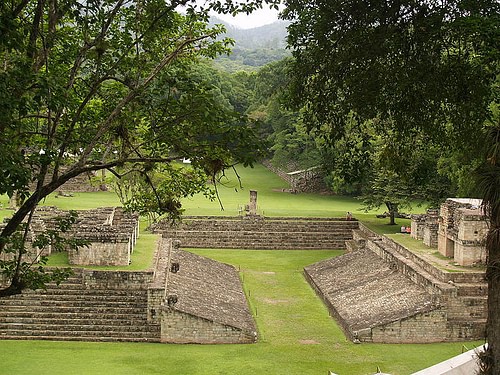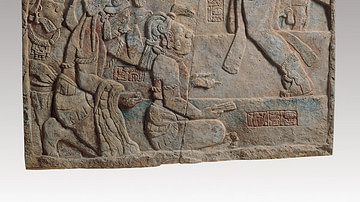
Yax K'uk' Mo' (pronounced `Yash Kook Mo') was the founder and first king of the dynasty that ruled the Maya city of Copan (in modern day Honduras) for 350 years. Known formally by his royal name, K'inich Yax K'uk' Mo', he reigned for eleven years from 426-437 CE. His name is translated as `Radiant First Quetzal Macaw' or `Sun-Eyed Green Macaw' or even `Sun In The Mouth of the Quetzal Bird'. The many interpretations of his name are reflected in the various theories regarding his origins. He was not native to Copan, and scholars speculate that he may have come from Teotihuacán, from Tikal or Caracol, or from some other region entirely. All that is clearly known is that a man named K'uk Mo' Ajaw emerged from some locale distant from Copan in 416 CE, took part in some kind of military action, and became king in 426 CE.
That he ruled well, and was greatly respected, is attested to by the tributes of later rulers and the archaeological record which makes clear that Yax K'uk Mo' essentially built what is today recognized as the Maya city of Copan. Information regarding his life comes from engravings on stele, monuments, and temples found at Copan and nearby Quirigua including (though by no means limited to): the famous Altar Q (commissioned by the last king of Copan, Yax Pasah, depicting the 16 kings of Copan beginning with Yax K'uk Mo'); Copan Stele E (which tells of his wounding, or `downing', in the military engagement of 416 CE); Copan Temple II (which was dedicated as `The House of Yax K'uk Mo'); The Xulpi Stone (a funerary marker dedicated to Yax K'uk Mo' in 437 CE); and the Motmot Marker (a Maya lowland monument) which is the first depiction of the king.
Place of Origin & His Famous `Goggles'
K'uk Mo's name connects him with the city of Tikal, especially owing to the Hombre de Tikal statue which, though headless, depicts a warlord and is carved with the name `K'uk Mo'. Scholars disagree, however, on whether this is a depiction of the great king of Copan or another warrior. The Mayanist David Stuart has pointed out that the designation `K'uk Mo' was fairly common in the region. Even so, Yax K'uk Mo' was also known as `Lord of the West' (the only ruler of Copan to hold that title), which was an honorary designation carried by kings of Tikal and, most notably, by the early ruler of Tikal Siyaj K'ak' who initiated the rise of that city in 378 CE and whose exploits Yax K'uk Mo's rise to power seem to have emulated. Some depictions of Yax K'uk Mo', however, present him in Teotihuacán attire and adornments; his `goggles' are associated with the rain god Tlaloc, venerated in the city of Teotihuacán, which also link him to that region.
The `goggles', which some writers have speculated are proof of ancient alien activity in the rise of the Maya civilization (as they resemble pilot's goggles), are not eye protection but, rather, part of the king's ceremonial headdress. The title `sun-eyed' (Kinich) in his name was also used by rulers in Teotihuacán who wore similar headdresses with what appear to be goggles over the eyes. This adornment over the eyes possibly represented the ruler's separation from the common people and association with the penetrating gaze of the gods (as represented by the sun). David Stuart, however, argues against Teotihuacán as point of origin claiming that Yax K'uk Mo's name represents birds native to southern Mesoamerica but not to the region around Teotihuacán. Stuart writes,
All in all, one can simply conclude from the earliest dynastic art and inscriptions that K'inich Yax K'uk' Mo' was a Maya king, but with important foreign contacts and associations" (239). Stuart also points out that the Motmot Marker is a purely Mayan creation, is the earliest depiction of Yax K'uk Mo', and presents him in Maya dress. Stuart then concludes that "he was a Maya lord thoroughly imbued with Teotihuacán traditions. (193)
His contacts with Teotihuacán, his military experience, and probable early political skill, all enabled him to expand the power and prestige of the city of Copan to the point that it can be said he re-founded the city.
Copan, Quirigua, & Tikal
The city of Tikal was at the height of its power at the time of Yax K'uk Mo's appearance in Copan. The historian Maria Longhena writes, "A series of factors, including the strategic position of Tikal in the Maya cultural area and its historical development recorded on its monuments, have recently led epigraphers Nikolai Grube and Simon Martin to formulate a theory that Tikal and Calakmul together held a dominant position over other Maya city states of the Classic Period" (243). It is because of Tikal's prominence that scholars have surmised that Yax K'uk Mo' probably was supported by that city's regime in his ascent at Copan or that his rise to power was the result of a coup initiated by Tikal which was first attempted in 416 CE and accomplished in 426 CE. The neighboring city of Quirigua was founded by the kings of Copan prior to Yax K'uk Mo's arrival and was subordinate to the mother city throughout most of its history.
An inscription on the top of Altar Q at Copan tells how the founder, then known as K'uk Mo' Ajaw, traveled from far off and, on 5 September 426 CE,
is said to have `taken K'awiil', in the sense of grasping a scepter in the form of the snake-footed deity, thereby marking a transition to regal status. Three days later, now carrying his full royal name, K'inich Yax K'uk' Mo' he comes to the wi te' naah, which may translate as "Root House", a structure linked to the foundation of dynasties, with strong central Mexican associations. On this occasion, at least one other lord from the region, the king of Quirigua, is known to have acceded. The location [of the Root House] is not stipulated but its distance from Copan is implicit in the 152 days that intervene before the founder's `arrival here' at Ox Witik, the principal place name of Copan (Martin and Grube, 192).
This inscription is interpreted to mean that Yax K'uk Mo' received his commission (or power) from Tikal (associated with the 152 day journey), went first to Quirigua, to install a ruler loyal to his cause in that city, and then came (or marched at the head of an army) to Copan. Upon his arrival, he would have found a small but impressively constructed city in a fertile valley close by the Copan River; in the eleven years of his rule the city would expand through massive building projects which raised huge temples and pyramids in the style of both Tikal and Teotihuacán.
The Xulpi Stone & The Hunal Tomb
Yax K'uk Mo' presided over the festival at the end of the 9th Baktun with his son, K'inich Popol Hol, on 11 December 435 CE. A Baktun is a time period of 394 years, or 20 Katun cycles of 144,000 days, the beginning and ending of which was marked by important celebrations by the ancient Maya (and by their descendents in the present day). It is unclear whether his son had assumed rule at this time and Yax K'uk Mo' had retired or if they were joint rulers, but it seems that father and son performed rituals of equal importance at this festival. The Xulpi Stone, a funerary marker dated 30 November 437 CE, was commissioned by K'inich Popol Hol in honor of his father, and so Yax K'uk Mo's death is dated to that year but it is possible he died earlier than the date on the stone. A significant aspect of this marker is that Yax K'uk Mo' is personally linked with Siyaj K'ak', the Warlord of Tikal, who also arrived `mysteriously' in that city in 378 CE and initiated the building projects and expansion which made Tikal so prosperous.
In 2000 CE, archaeologists working at Copan uncovered the tomb of an early king now recognized by most scholars to be K'inich Yax K'uk Mo'. The central position of the tomb in the city and the personal items interred with the body all strongly suggest identification with the first great king of Copan. More significantly, however, as the historian Geoffrey E. Braswell notes, these items correlate precisely with Yax K'uk Mo's depiction on Altar Q: "the individual in the Hunal tomb suffered a severe parry fracture of the right forearm consistent with the depiction of K'inich Yax K'uk Mo's warrior portrait on Altar Q, in which he is shown holding a small shield protecting his right forearm." Strontium isotope analysis of the skeleton's teeth revealed that he was not native to Copan but spent his youth south of the city in the Peten Basin and only lived in the area of the city in the last years of his life. Further support for the Hunal tomb's skeleton being that of Yax K'uk Mo' is the neighboring tomb of the so-called "Lady In Red". It is thought that Yax K'uk Mo' legitimized his rule of Copan by marrying a noble woman of the city. Careful analysis of the "Lady In Red" skeleton shows that she was born in the Copan region, her rich attire designates her as royalty, and her proximity to the king's tomb links her as a close relative.
The Xulpi Stone and the Hunal Tomb, when considered with Altar Q and the rest of the inscriptions at Copan (such as the badly eroded Hieroglyphic Staircase), seem to substantiate Yax K'uk Mo' as a warlord from Tikal who emulated the life of the early hero Siyaj K'ak' and created a metropolis at Copan that he hoped would mirror the grandeur of the mighty Tikal. He succeeded in his goal and laid the foundation of a dynasty which, for 350 years, concentrated on the development of art, culture, trade, expansion through military campaigns, and magnificent building projects. The 16 kings of Copan are honored as equals in their representation on Altar Q because of the uniformity of their efforts and accomplishments in improving the lives of the citizens of the city. All seem to have followed Yax K'uk Mo's policies and vision for the city and each cared for and improved upon the efforts of their predecessor. In 1988 CE, excavations at Copan uncovered a crypt next to Altar Q which contained the remains of 15 jaguars which had been sacrificed in 775 CE by the last king of the dynasty, Yax Pasah, in honor of his 15 predecessors. This, along with the record each king added to, illustrates the cooperative and progressive vision of the rulers of Copan in that, instead of trying to personally surpass their predecessor, they honored the former ruler by maintaining the same vision and policies.
The Decline of Copan
In 738 CE the thirteenth king of Copan, Uaxaclajuun Ubaah K'awill, was captured by the king of Quirigua and beheaded. Longhena writes, "This marks a dramatic moment for the political and military prestige of the city of Copan which, at that time, was enjoying a particularly splendid period and must have been one of the most important and populous Maya cities" (252). Quirigua had clearly thrown off its vassal status by this time and was actively competing with Copan for primacy. Copan seems to have become increasingly populated during this time and artworks from the period depict more military conflict than works from earlier periods. Large building projects continued during this time but, when the sixteenth ruler of Copan, Yax Pasah, took the throne in 763 CE, he initiated a different kind of art. His reign is marked by more modest buildings and an emphasis on the history of the city.
Under Yax Pasah the Hieroglyphic Stairway, which was first built in 710 CE to chronicle the history of the city, was refurbished and Altar Q was created. The attention paid to both of these monuments, and the further hieroglyphic art commissioned under the reign of Yax Pasah, reflect a concern with recording the glory of the past in an uncertain present. Yax Pasah's rule ends the dynasty founded by Yax K'uk Mo', and the last king of Copan, a ruler by the name of Ukit Took, left behind him an unfinished altar and no improvements or renovations to the city's structures. The population of Copan declined as resources became more and more scarce. Overuse of the land, and a population grown too large for the water supply, led to a steady exodus from the city and a sharp decline in its prestige. The Katun Celebration of 810 CE was held at Quirigua, not Copan and, by 830 CE, the city was abandoned.








